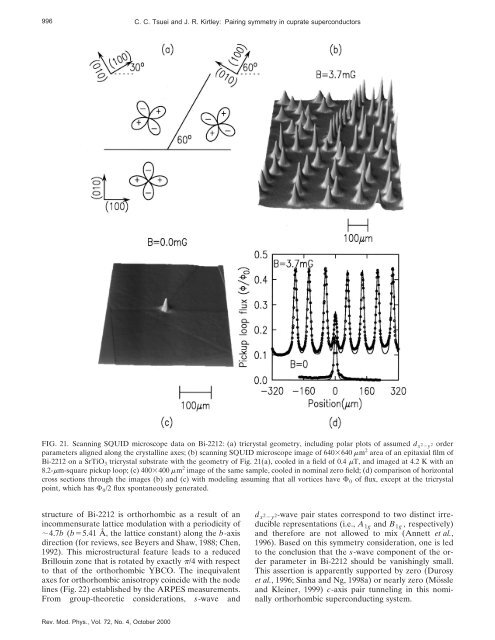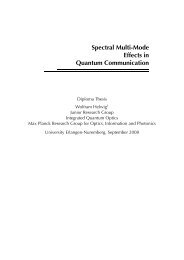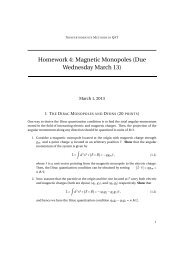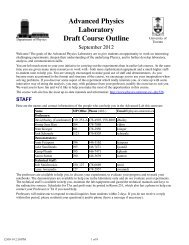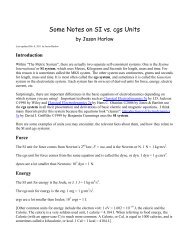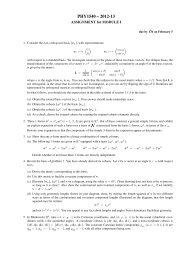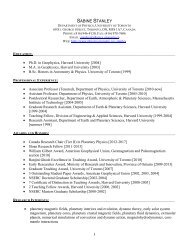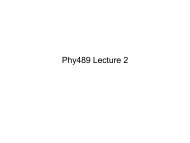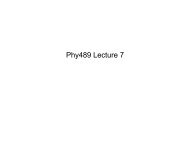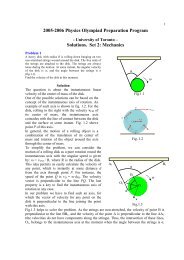Kirtley and Tsuei - Physics
Kirtley and Tsuei - Physics
Kirtley and Tsuei - Physics
Create successful ePaper yourself
Turn your PDF publications into a flip-book with our unique Google optimized e-Paper software.
996 C. C. <strong>Tsuei</strong> <strong>and</strong> J. R. <strong>Kirtley</strong>: Pairing symmetry in cuprate superconductors<br />
FIG. 21. Scanning SQUID microscope data on Bi-2212: (a) tricrystal geometry, including polar plots of assumed d x 2 y 2 order<br />
parameters aligned along the crystalline axes; (b) scanning SQUID microscope image of 640640 m 2 area of an epitaxial film of<br />
Bi-2212 on a SrTiO 3 tricrystal substrate with the geometry of Fig. 21(a), cooled in a field of 0.4 T, <strong>and</strong> imaged at 4.2 K with an<br />
8.2-m-square pickup loop; (c) 400400 m 2 image of the same sample, cooled in nominal zero field; (d) comparison of horizontal<br />
cross sections through the images (b) <strong>and</strong> (c) with modeling assuming that all vortices have 0 of flux, except at the tricrystal<br />
point, which has 0 /2 flux spontaneously generated.<br />
structure of Bi-2212 is orthorhombic as a result of an<br />
incommensurate lattice modulation with a periodicity of<br />
4.7b (b5.41 Å, the lattice constant) along the b-axis<br />
direction (for reviews, see Beyers <strong>and</strong> Shaw, 1988; Chen,<br />
1992). This microstructural feature leads to a reduced<br />
Brillouin zone that is rotated by exactly /4 with respect<br />
to that of the orthorhombic YBCO. The inequivalent<br />
axes for orthorhombic anisotropy coincide with the node<br />
lines (Fig. 22) established by the ARPES measurements.<br />
From group-theoretic considerations, s-wave <strong>and</strong><br />
d x 2 y2-wave pair states correspond to two distinct irreducible<br />
representations (i.e., A 1g <strong>and</strong> B 1g , respectively)<br />
<strong>and</strong> therefore are not allowed to mix (Annett et al.,<br />
1996). Based on this symmetry consideration, one is led<br />
to the conclusion that the s-wave component of the order<br />
parameter in Bi-2212 should be vanishingly small.<br />
This assertion is apparently supported by zero (Durosy<br />
et al., 1996; Sinha <strong>and</strong> Ng, 1998a) or nearly zero (Mössle<br />
<strong>and</strong> Kleiner, 1999) c-axis pair tunneling in this nominally<br />
orthorhombic superconducting system.<br />
Rev. Mod. Phys., Vol. 72, No. 4, October 2000


